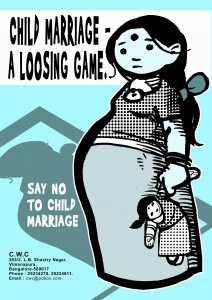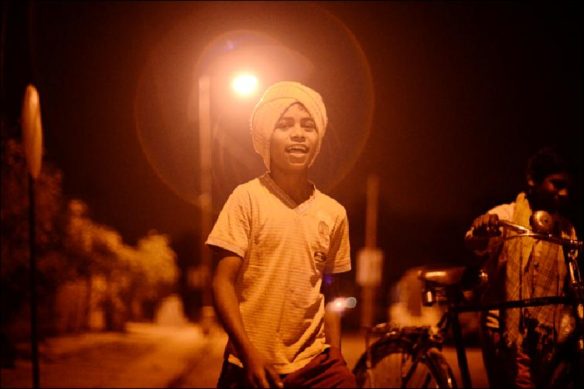Child marriage
Child marriage is rampant in many parts of India despite being prohibited by various laws, most recently the Prohibition of Child Marriage Act, 2006.
Most girls who are forced into child marriages are around 12 years old. Many are taken out of school and used as bonded labour by their new families. Many are sexually abused and raped by the men in their new families. Most will go through multiple pregnancies while still minors. Many die young.
Nevertheless, child marriage is encouraged in many rural areas of India, particularly in areas where communal ‘mass marriage’ ceremonies are common. Female children are often considered a liability, both financially as well as with regard to their safety. Many adults and children are unaware of the immediate as well as the long-term consequences of child marriage. Those who are aware do not have sufficient social support to take strong positions against it, and the laws on child marriage are extremely weak.
A survey conducted in Bellary District of Karnataka by the Concerned for Working Children (CWC) in 2001 found that the average age of marriage for males was 18.1 years and for women, 13.9 years.
CWC has been battling child marriage in Karnataka for many years. In line with our philosophy, we have focused on enabling children to take action in their own communities and at state level to prevent child marriage.
Our philosophy: Children should be their own first line of defence and participate in an informed manner in all decisions concerning them.
Children as agents of change
“She is a child herself. Why burden her with another child?”
“A child should call ‘mother’, but a child should not be called ‘mother’. No marriage for children at all.”
“Good marriages take place slowly. Go slow with children’s marriages.”
– Slogans created by children in CWC workshops
Our approach is to empower children to make change in their own communities. Members of organisations facilitated by CWC for the empowerment of children have prevented many instances of child marriage in their villages through campaigning in their own villages.
In 2002, for example, members of Bhima Sangha (the union of working children facilitated by CWC) staged a protest in their village to help their friend Vedha, 11, from being pushed into an early marriage. Despite the opposition of their parents and neighbours, the children marched to the police station and demanded action to stop the illegal marriage. Policemen gave Vedha to the children for protection until after the wedding date, and she stayed with other members in their small training centre. Since Vedha’s case, many children have been saved from early marriage by activism by their Bhima Sangha friends.
In addition to facilitating children’s organisations, we work directly with communities to help tackle the root causes of child marriage. Through field work and through our educational institute Namma Nalanda Vidyapeetha, we have provided residential educational opportunities for hundreds of young women and helped them and many others find new sources of income which can reduce pressure from families to marry early.
CWC has developed educational material in multiple languages to educate parents and children about the negative consequences of child marriage. The poster above, for example, was developed by CWC and distributed by Bhima Sangha members around their communities.
In 2004-6, thanks to a MacArthur Fellowship, CWC was able to work on a two-year project developing educational materials about child marriage, gender and sexuality. The resulting handbook, Nanna Deha, Nanna Manasu (“My Body, my mind”), has become a popular tool with teachers in Karnataka. We then formed a partnership with schools organisation Sarva Shiksha Abhyan and conducted workshops with over 2000 adolescent girls all over Karnataka to discuss gender, sex and sexuality rights. We believe that rights-based sex education can help empower girls to resist pressure to marry early.
Defining and promoting ‘ideal marriage’
At the same time, CWC and members of the organisations we facilitate have carried out educational and protest campaigns in their communities and at state level to change attitudes to child marriage. In 2004, with help from CWC, members of Bimha Sangha developed a model of Adarsha Vivaha – ‘ideal marriage’. They organised an event at which a number of marriage ceremonies took place. All the brides and grooms involved provided evidence that they were above the legal age of adulthood (18 for women, 21 for men) and no dowries were given or received. Each couple received counselling and information about sexual health, family planning and sexuality rights.
Our efforts proved influential. In 2007, the Government of Karnataka introduced its own Adarsha Vivaha scheme, offering cash rewards to young couples who get married in mass ceremonies if their marriages are properly registered and age-verified. In addition, many of the ideas behind the original Adarsha Vivaha, including the requirement of written evidence of age at mass marriage ceremonies, were incorporated into the State Action Plan for Prevention of Child Marriage.
Effective advocacy
We then helped children campaign take their campaign against child marriage to state level. In November 2005 CWC, Bhima Sangha and Namma Sabha – an alliance of former working children who have reached adulthood, facilitated by CWC – held a rally against child marriage in Cubbon Park, Bangalore, attended by over 300 children and adults representing over 7500 people across Karnataka. In April 2006 the Campaign met the Chief Minister of Karnataka, H. D. Kumaraswamy, who promised to “take effective measures to put an end to child marriages.” The government introduced its Adarsha Vivaha (‘ideal marriage’) scheme the following year.
It took until 2010, and the setting up of the Core Committee for the Prevention of Child Marriage headed by Hon. Justice Dr. Shivraj V. Patil, that the Government took a serious look at the child marriage problem. CWC contributed extensively to the committee. Our director Kavita Ratna was a member of the committee and lead the sub-group on children’s participation. Other members of staff contributed to sub-groups on mass marriages and education.
In line with our focus on children’s participation, we also impressed upon the committee the need for children to have direct input into the report, leading to several district-level consultations with children.
The resulting report, published in 2011, reflected our input in several key areas: an emphasis on alternatives to marriage for girls, including scholarships and alternative housing; attention to the wider socioeconomic context of child marriage, including drought conditions and declining rural livelihoods; and an entire chapter devoted to ensuring children’s participation in the prevention of child marriage. The report also includes an appendix produced by CWC providing information for field activists on existing support available for families to prevent child marriage.
Read the Patil committee report.
Child marriage: our policy
CWC believes that responsibility for monitoring and preventing child marriages should be devolved from district level to village level.
Because of their proximity to the affected parties, Grama Panchayats (village councils) are best placed to prevent child marriage and take disciplinary action against those who allow or organize such marriages.
Births and marriages, including mass marriages, should be compulsorily registered through Panchayat Development Officers.
Panchayats, along with religious and social leaders, should use Grama Sabhas (village meetings), schools, sports events and cultural gatherings to create awareness of the harmful effects of child marriage. Children and adults alike should be provided with safe methods of reporting potential child marriage situations.
Read our full policy on child marriage.



